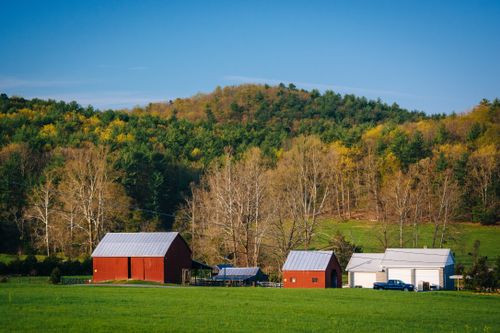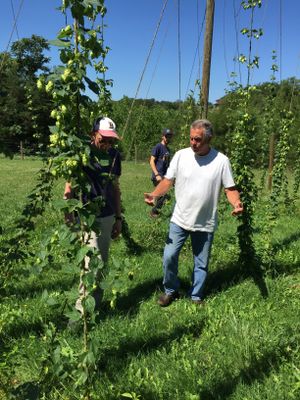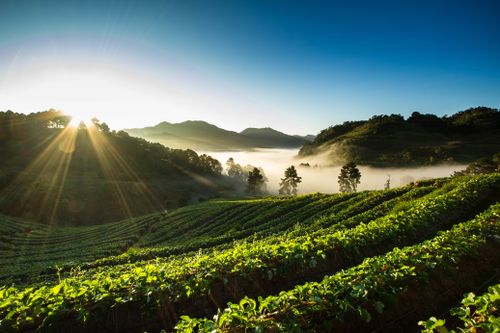A Change from the past
Farming in Virginia today is very different than the farming the state was founded on. In the beginning, farming was all about tobacco, it was the cash crop to grow. Now with a decline in tobacco use and a rise in wine consumption, the land that used to be used for tobacco is being taken over for wine. The farms used to be run by the man of the family and it was a male dominated field. Today more women are becoming successful farmers. There has been many changes in the industry over the years but one thing stayed constant, Virginia farming is the foundation of the state.
A thriving industry today
When you think of Virginia you may think of think of the Civil War and hiking in the mountains, but you might not think about farming and agriculture. Virginia is bursting with farms, from beef farms to fruit farms we got it all! Which is why agriculture is the top industry in Virginia.
Today driving through Virginia you’ll see farms as far as the eye can see. Always passing more. Even though many people know that agriculture here is important they may not know just how important it is and that this state was founded because of farming and agriculture.
Now Virginia agriculture boasts farms of all types which include:
- Meat farm
- Dairy farm
- Fruit farm
- Vineyards
- Orchards
- Crop Farm
- You Pick Farms
Early Virginia History
Jamestown, our first successful settlement in Virginia, was not set up by the English government like is widely believed, but was actually set up by The Virginia Company of London to start farming while here in the New World. The whole point of the expedition was for colonists to go to America and bring profit to the company back in London. It was set up to be a trading colony with ships coming back with goods ranging from silks to wine on board. The colonists had to find ways to gain profit so they looked to farming.
Agriculture was a major part of the early economy of Virginia. The Jamestown settlers already farmed wheat and corn for their own sustainability and then learned from the Native Americans how to farm tobacco too, which soon became Virginia’s first export.
The settlers learned how to farm and trade tobacco. Once they had a foothold in the tobacco industry, the colonists then moved onto vineyards. The soil and weather was better in Virginia than in London which made it easier for them to grow bountiful grape vines. Thus the beginning of today’s wine industry here in Virginia.
Even with grapevines growing naturally in Virginia, the first batch of wine to travel to London was not what as good as the company was expecting. The wine was bitter and the English thought it was another sign of a failing expedition. The colonists didn’t give up hope on their wine and by the end of the 17th century, every home had a vast amount of wine stocked in their home which isn’t too different from today.
The change to grain and livestock
Tobacco continued to be Virginia’s cash crop through the 17th and 18th century but towards the end of the 18th century, around the time of the American Revolution, farmers started to grow more and more grains and raise more livestock. These grains ended up being a cash crop too because they were cheaper to grow, required less workers and they did not deplete the land the same way tobacco did.
Before the Civil War farms and plantations and vineyards were booming. President Thomas Jefferson loved the Virginia wine so much that he spent a fortune on it while in office. Jefferson was so influential that the Virginia wine making industry flourished during his time.
The Civil War wiped out many of these vineyards since many battles were held in Virginia. The industry didn’t take off again until much later due to the prohibition period being soon after the Civil War and then the depression that wine-making wasn’t able to gain traction again until the mid 1970s.
Birth of the today’s small farms
Even though the wine-making needed to stop in the 20th century, farms flourished. The first two decades of the 1900s was agriculture’s Golden Age throughout the nation. When the first World War ended so did the agricultural Golden Age. Virginia farms were able to hold their own during this time better than others but when the Great Depression hit, they got hit the worst. Only to bounce back during the next World War.
Today small farms are the backbone of our state. Virginia is home to 45,000 that take in about 70 billion dollars annually. The Shenandoah Valley holds four out of the five largest agricultural counties. The small farms are the leading drivers of the state’s agricultural economic development with about 90% of the total farm population being run by an individual or a family.
Even with their comeback during the war, there are only half as many farms today as their was a hundred years ago. There are less farms now but the Virginia farming and agriculture industry today has a large economic impact . With so many different types of farms, there’s one for everyone to enjoy and we’re glad they’re all here!



